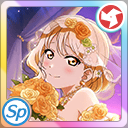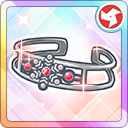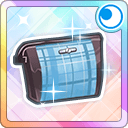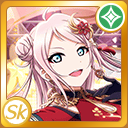Table of Contents
Syntax
Base syntax of the wiki is documented on the DokuWiki site: syntax
This wiki has some plugins to allow for some more syntax. Some of them are available as buttons in the editor, others are not, so here's a few of those. This is not all - but if you see something not covered and you're curious about how it works, you can just edit the page where it's used, and look at the markdown or just copypaste it.
Automatic Card Links
Card references in this format will be automatically converted to links with thumbnails:
(S/P/C/A/N/E)(Vo/Sp/Gd/Sk) [R/SR/Fes/Party] Name [Number]
The first three letters are the first letter of the attribute followed by the type. If there are multiple cards with the same attribute/type combination, you can specify the optional number at the end to select another card (if you leave out the number, it defaults to 1). The reference is case-sensitive.
The name must be the member's first name (for example, Yoshiko/Hanamaru instead of Yohane/Maru). Rarity is optional - by default, only URs will be searched, so you will have to specify SR or R for those. However Fes/Party are included in the URs searched by default, so if the attribute/type combination is unique among those, you can leave out the Fes/Party specifier and it'll be added automatically.
CSk Lanzhu → 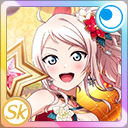 CSk Lanzhu
CSk Lanzhu
AVo Kanan → 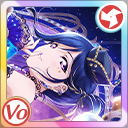 AVo Fes Kanan
AVo Fes Kanan
PSk Honoka → 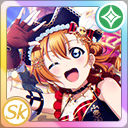 PSk Party Honoka
PSk Party Honoka
PSk Honoka 1 →  PSk Party Honoka
PSk Party Honoka
PSk Honoka 2 → 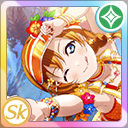 PSk Honoka
PSk Honoka
CSp SR Kanan →  CSp SR Kanan
CSp SR Kanan
Card Thumbnails
For card listings or tables, you might prefer a bigger thumbnail instead of a text link. You can add a card's image by using {{card:X}}, where X is the card's School Idol Number, as seen in-game when sorting by it or in the URL of databases such as Kirara, or a Attribute/Role reference like the Automatic Card Links. Use {{card:unidolized:X}} if you want to show the unidolized thumbnail.
{{card:480}} {{card:unidolized:480}} {{card:ASp Ai}}
Attribute/Type/Group/Skill Icons
| Attributes | Types | Groups | Skills | ||||||
|---|---|---|---|---|---|---|---|---|---|
 | {{attr:s}} |  | {{type:vo}} |  | {{group:m}} |  | {{skill:appeal}} |  | {{skill:spocpower}} |
 | {{attr:p}} |  | {{type:sp}} |  | {{group:a}} |  | {{skill:cleanse}} |  | {{skill:sppower}} |
 | {{attr:c}} |  | {{type:gd}} |  | {{group:n}} |  | {{skill:critchance}} |  | {{skill:uncapcrit}} |
 | {{attr:a}} |  | {{type:sk}} |  | {{group:1}} |  | {{skill:critpower}} |  | {{skill:vogain}} |
 | {{attr:n}} |  | {{group:2}} |  | {{skill:dr}} |  | {{skill:voplus}} |
||
 | {{attr:e}} |  | {{group:3}} |  | {{skill:heal}} |  | {{skill:p:appeal}} |
||
 | {{attr:x}} |  | {{group:f}} |  | {{skill:shield}} |  | {{skill:p:stamina}} |
||
 | {{group:b}} |  | {{skill:skillchance}} |  | {{skill:p:technique}} |
||||
 | {{skill:spfill}} |  | {{skill:p:typebonus}} |
||||||
 | {{skill:spgain}} | ||||||||
Accessory Thumbnails
{{acc:X:A}} allows you to show an Accessory's icon, where X is the short name of an Accessory (bangle, belt, bracelet, brooch, choker, earring, hairpin, keychain, necklace, pouch, ribbon, towel or wristband) and A is the first letter of the attribute. Currently, only regular and DLPDLP: Short for "Dream Live Parade". A monthly singleplayer event where you try to clear as many Lives as possible with limited Card usage.➔ Learn More Accessories are supported.
{{acc:bangle:a}} {{acc:pouch:c}}
Limit Break Icons
Using {{lb:X}}, you can append a Limit Break count below a Card or Accessory thumbnail. Together, these are made to be used for Formation setups in the Songs namespace. Note that writing “mlb” won't work, you have to put {{lb:5}} for that.
{{card:531}}{{lb:4}}
TeX
TeX can be used to make nice and beautiful math. Open a math environment as you would in a TeX document. In there, you can do almost anything you can do with TeX, including math symbols or opening more environments using \begin.
TeX can be inlined: $x=5$ or put in a seperate paragraph: $$a^2 = 3 \cdot \frac{a}{2}$$
TeX can be inlined: $x=5$ or put in a seperate paragraph: $$a^2 = 3 \cdot \frac{a}{2}$$
Right Floating Wrap

Floating wraps are useful for putting infoboxes, images, videos or anything else on the side.
<WRAP right>text</WRAP>
One other useful wrap is the “clear” wrap, which will add empty space to the text until the floating wrap is over, like here. You should use it if you have a long floating wrap, but only a short text, so the next section doesn't get mushed next to the float as well. You can find it in the Wrap menu in the editor (⏏ symbol, “clear floats”).
YouTube Embed
{{youtube>VIDEOID}}
The video ID is taken from the YouTube URL (the part at the end - for example, for https://www.youtube.com/watch?v=yRZPhvonGB8 the video ID is yRZPhvonGB8).
Graphs
The ApexCharts plugin allows you to make fancy interactive graphs. Check the ApexCharts examples page to see what is possible.
To use an ApexChart here, copy the value of what would be in the options array (everything inside and including {…}) and put it between <achart> tags. Take a look at the source of Bonus Costumes for an example of it in action.
Tabs
<tabbox The First Tab Title> Hello, I am the first tab. <tabbox The Other Tab Title> Look at me, I am more text. <tabbox selected The Default Tab Title> Put "selected" behind "tabbox" to have a tab selected by default when opening a page. </tabbox>
The First Tab Title
Hello, I am the first tab.
The Other Tab Title
Look at me, I am more text.
The Default Tab Title
Put “selected” behind “tabbox” to have a tab selected by default when opening a page.
The “selected” property is optional - if you don't add it to any tabs, the first tab will be selected by default. Please do not use this to section pages - use headings instead, so they show up in the Table of Contents. This should rather be used for things like alternate representations of the same info (table/bar graph/line graph…) or images (the Idolized/Unidolized images in the Card page infoboxes).
Table Widths
You can set table widths by writing |< >| before a table and putting widths in-between. The first width will be the overall table width, followed by the width of each column. You can also put `-` if you don't want to specify a fixed width - colums marked with that will automatically distribute leftover width.
|< 75% 10% 20% - 50% >| ^ 10% ^ 20% ^ the rest ^ 50% ^ | | | | |
| 10% | 20% | the rest | 50% |
|---|---|---|---|
Table Cell Colouring
If you want to highlight a single cell in a table, you can do so by changing the background colour:
^ ^ A ^ B ^ ^ 1 | @red:A1 | @lightblue:B1 | ^ 2 | @mediumspringgreen:A2 | @#126126:B2 |
| A | B | |
|---|---|---|
| 1 | A1 | B1 |
| 2 | A2 | B2 |
Comments and Markers
Markers are simple way to mark spots in pages which are in need of further work. There are three markers you can put:
[(:fixme)]: This part needs to be reworked, to be easier to understand.
[(:todo)]: This note points out that there should be further information about this topic here.
[(:proof)]: This part should have some proof or citation about its claims.
Use these markers when starting out with a new page, to mark locations where other editors can help and contribute.
You can also do longer comments that will not be visible on the page, but only if you're editing - to explain something in more detail:
<!-- Hello, this is a comment. It can even do linebreaks. -->
Footnote Names
The footnotes, as described on the DokuWiki page, work fine for marking the source of something or citing a reference for some information:
This is a fact ((and this is the source for that fact))
This is a fact 1)
But if you use a reference multiple times in a page, you can save a lot of writing by giving the references a name:
This is a fact ((my_ref_name>and this is a source I will use multiple times))
This is a fact 2)
The part before the > is the name for the reference, and later in the page you can simply use that name instead of typing out the whole reference:
This is another fact ((my_ref_name))
This is another fact 3)
DLP Parade Table
The DLP_PARADE tag can only be used in the events:dlp: namespace and allows you to automatically generate the overview table found at the top of Parade pages.
<DLP_PARADE>...</DLP_PARADE>
The DLP_PARADE tags should enclose the entire page except for the first Level 1 headline showing the page name. The enclosed area will be scanned for Level 3 headlines with the floor numbers and names, and the information from the tables below them is extracted to create a table where the opening <DLP_PARADE> tag sits. (It is recommended to just copy an existing floor or parade page to make sure the layout matches!)
To add icons, you can use special icon tags, similar to the ones above, like this:
^ {{dlp:type:vo:+1}} | Description for this note |
Note that the table syntax is used here like a normal row, but with only two columns instead of the seven that would be expected. The padding columns are automatically added when the icon is scanned.
The following icons can be used. X should be replaced with a value that signals which arrow symbol should be drawn: -2 stands for “No need”, -1 for “Save, +1 for “Useful” and +2 for “Important”. You can also put 0 if you don't want to assign an importance to the icon, in case it just serves as information instead of a teambuilding hint.
| Attributes | Types | Groups | Roles | ||||
|---|---|---|---|---|---|---|---|
 | {{dlp:attr:s:X}} |  | {{dlp:type:vo:X}} |  | {{dlp:group:m:X}} |  | {{dlp:scoring:X}} Scoring |
 | {{dlp:attr:p:X}} |  | {{dlp:type:sp:X}} |  | {{dlp:group:a:X}} |
||
 | {{dlp:attr:c:X}} |  | {{dlp:type:gd:X}} |  | {{dlp:group:n:X}} |  | {{dlp:healing:X}} SustainSustain: A collective term for any kind of damage mitigation - Healing, Shielding and Damage Reduction cards. |
 | {{dlp:attr:a:X}} |  | {{dlp:type:sk:X}} |  | {{dlp:group:1:X}} |
||
 | {{dlp:attr:n:X}} |  | {{dlp:group:2:X}} | ||||
 | {{dlp:attr:e:X}} |  | {{dlp:group:3:X}} |
||||
The Attribute, Type and Group icons can be moved into the “Backline” column of the overview table by putting backline: right after DLP - so, for example, {{dlp:backline:type:vo:+1}}.
The icons for the “Other” column serve as FYIs in regards to AC types or other common obstacles to watch out for when building formations. These do not take an X value.
 | {{dlp:other:cleanse}} Cleansable |  | {{dlp:other:swap}} Swaps Required |  | {{dlp:other:sp}} SP AC |
 | {{dlp:other:crit}} Crit AC |  | {{dlp:other:skill}} Skill AC |  | {{dlp:other:stamina}} Stamina AC |
Contributors to this page:

